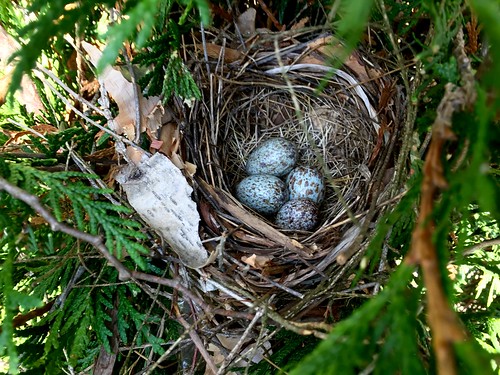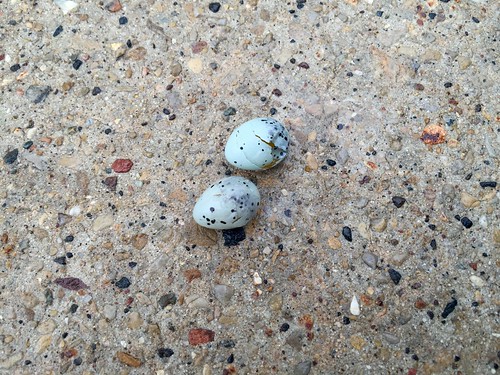
... a cardinal's eggs!
Finding and photographing by Meade.
IN THE COMMENTS: Quaestor said: "Wasn't there an egg on the sidewalk some years ago that we debated the identity of?"
Yes! Here: "Breakage." It looked like this:

Not the same. Blue with spots, but different.




30 comments:
Wasn't there an egg on the sidewalk some years ago that we debated the identity of?
Looks tasty.
Beautiful !!
"Wasn't there an egg on the sidewalk some years ago that we debated the identity of?"
Good memory. Yes!
I am pea-green with envy. I have seen a cardinal only once in my life, in Texas. We don't have them in Montana. Seemed like East and Midwest have better songbirds than we do out west.
Beautiful!!!
Carol, don't forget the Western Meadowlark!
I've enjoyed watching the parenting of the eagles chicks at the National Arboretum in D.C.
Carter Wood wrote: Carol, don't forget the Western Meadowlark!
As I recall in the "Breakage" discussion I deduced the ID as Meadowlark, but the consensus was cardinal. I'm assuming Meade has seen the nesting pair tending this clutch, which clinches the ID. Now that we have confirmed cardinal eggs for comparison, should we not revisit "Breakage"?
I've enjoyed watching the parenting of the eagles chicks at the National Arboretum in D.C.
Eagles don't hatch "chicks", they hatch eyasses.
I saw a male cardinal in my yard this morning. The babies make quite a squawking racket after they hatch, so be prepared.
Toy
Cardinal eggs — blue with many dark brown spots, at least 50% brown.
Western Meadowlark eggs — paler blue with much fewer spots, at least 75% blue.
Picture
I have two. The bright red are males, the grayish reds are known as fawns. They've lived in my yard for three years. This time of year is what I call the "romance dance". The male feeds the female to curry her favor. Rather cute..........
Buy some black sunflower seed..........
Quaestor, isn't the correct term "eyasmusket?"
Anyway, video from when the eaglings had just hatched.
Must have fallen out of the pope's protection...
tough crowd.
Cute little fetuses... prematurely aborted.
Here in St Louis we love cardinals. We usually see them still playing late in autumn.
We had two different pairs of nesting birds, but a new neighbor has a free range cat which I have seen in our backyard and it looks like the nests have been abandoned. I am torn. We put out lots of birdhouses and like to watch nesting birds, however the cat is killing chipmunks (or as I call them, rats in makeup) and considering how many tomatoes those things steal, I am mostly pro-cat.
Nesting time for the permanent residents, the neo tropical migrants are just showing up ... first Baltimore Oriole and first Blue Winged Warbler in the Pheasant Branch Creek corridor today.
It's birding season for the next month.
I love that the sidewalk, too, is speckled.
Quaestor, isn't the correct term "eyasmusket?"
The male sparrowhawk (Accipiter nisus) is called a musket. An eyas musket (two words) would be a musket taken into training before becoming fully fledged, and it would retain that appellation throughout its career because of its behavior and hunting style. A raptor taken as a fledged juvenile on its first migration is called a bird of passage, and a musket so taken is called a passage musket, and likewise retains that designation going forward. A male sparrowhawk taken as an adult is called a haggard musket. The females are called hawks, with the same descriptors. Females of the genus Falco are called falcons, while the males are called tercels. In North America male Cooper's hawks (Accipiter cooperii) are often called muskets. The bird sometimes called a "sparrowhawk" by Americans is not an accipiter but a true falcon; it's correct common name is American Kestrel. The closest analog of a sparrowhawk in North America is the sharp-shinned hawk (Accipiter striatus), but they're a bit delicate and temperamental for falconry. The name of that species could be called a musket.
The word musket was applied to raptors long before firearms were invented. Nearly every 16th century firearm, including cannons but excluding pistols, were named from the falconry lexicon. For example the most potent English galleons that opposed the Armada were armed with a 9-foot long cannon called a falcon. The firearm carried by infantrymen, being much smaller than a falcon, was called a musket on account of its size.
So the answer is no.
I'm generally stymied by common bird names and the rules of capitalization. Birders tend to capitalize names, while newspaper stylebooks usually demand lower case. I'm like some guidance from a good-humored orthography Nazi.
Typo: The name of that species could be called a musket.
Corrected: The male of that species could be called a musket.
@ Carter Wood
The chapter heading of the book you liked to is "Tassel Gentle" and evidently refers to the line from Romeo and Juliet.
"O for a falconer's voice
To lure that Tassel Gentle back again."
Orthography wasn't then as it is now, thus tassel = tercel. In Shakespeare's day the most prized hunting bird was, and is still today, the peregrine falcon (Falco pereginus). In fact it was so valued that in Chaucerian times no one below the rank of earl could own one. Earls are nobility, and another word for noble is gentle, as in gentleman. Thus what Juliet is talking about is a male peregrine falcon, a metaphor for Romeo.
Wow. How nice is that to have it in your backyard. I always feel excited when birds (mostly robins) build a nest under the deck. Robins lay blue eggs also.
@ Quaestor. Very informative. Thank you.
I just admitted last week to having never seen Romeo & Juliet, so here's another reason.
"I'm generally stymied by common bird names and the rules of capitalization."
The AOU Checklist, generally considered authoritative (at least by the AOU).
For safety reasons I would put all of the eggs in one basket.
I am Laslo.
Carol, don't forget the Western Meadowlark!
I haven't forgotten, in fact I felt guilty as I wrote that, because we are so blessed with Meadowlarks this year. Our trees have grown to such height, plus the perches DH built years ago for them, that they grace us all day long now. I have never heard such a variety in Meadowlark song as this year.
But a red cardinal is something, really something to behold.
But a red cardinal is something, really something to behold.
Yep.. I love red cardinals and fortunately we get a lot of them in our backyard.
Please don't get too attached as heartache always follows.
We had robins last year that had nested on our kitchen porch and that was pretty cool.
I quit grilling out there and didn't hang out there much as to not disturb their nest. The eggs hatched, babies born and then nature did what it often does best, within two weeks they were all dead.
The robins? They never came back.
Good luck.
Post a Comment
Please use the comments forum to respond to the post. Don't fight with each other. Be substantive... or interesting... or funny. Comments should go up immediately... unless you're commenting on a post older than 2 days. Then you have to wait for us to moderate you through. It's also possible to get shunted into spam by the machine. We try to keep an eye on that and release the miscaught good stuff. We do delete some comments, but not for viewpoint... for bad faith.